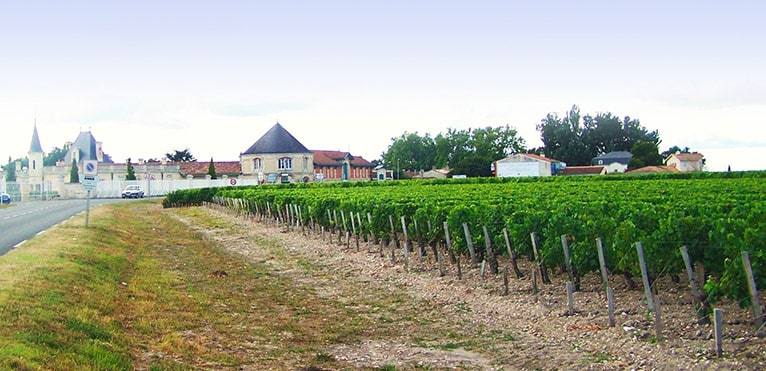
Contents
The Margaux appellation is the only communal appellation in the Médoc region to bear the name of a Premier Grand Cru Classé. Margaux is a wine-growing area recognized and appreciated internationally for both its Grands Crus Classés and its distinctive grain. Indeed, the wines of this appellation are known for their feminine elegance and voluptuous delicacy.
The great châteaux of Margaux recognized in 1855
Vines have been cultivated in the various geographical areas of the Médoc since antiquity, more than 2,000 years ago. However, grapes began to be vinified using practices that we still use in the 17th century. At the same time, innovations in cultivation have left their mark on the history of this terroir. Henri IV, for example, had Dutch engineers drain the Médoc marshes, enabling the Grands Châteaux to establish themselves. It’s also worth noting that these domains have retained their original roots.
This work also earned the Margalais vineyards wide recognition in the 1855 classification. The appellation’s eponymous Château has been awarded the title of Premier Grand Cru Classé, while 5 other Châteaux have been awarded the 2ème Grands Crus Classés, 10 of 3ème Grands Crus Classés, 3 of 4th Grand Crus Classés, and 2 from 5th Grand Cru Classé. A total of 21 Châteaux recognized by the classification required by Napoleon ahead of the Paris Universal Exhibition. During the 1920s-1930s, several estates were also recognized as Crus Bourgeois and Crus Artisans. Finally, in 1954, the commune of Margaux, along with Arsac, Cantenac, Labarde and Soussans, obtained the title ofAppellation d’Origine Contrôlée Margaux.
Margaux, a prestigious Bordeaux appellation
Located 25 kilometers north of the city of Bordeaux on the left bank of the Gironde, the Margalais vineyards benefit from a temperate climate, where the estuary softens temperatures. The Margaux AOC is made up of earthworks and gravelly hilltops ranging in height from 5 to 35 meters. In the center of the appellation, where most of the crus are located, the soils are white gravel. The edges of the appellation are largely limestone, covered with sediment.
Margaux is one of Bordeaux’s most prestigious appellations, producing 63,000 hectolitres of wine a year from its 1,400 hectares. In this appellation, the estates vinify mainly Cabernet Sauvignon and Merlot, as well as Cabernet Franc, Petit Verdot and Malbec. A small number of white wines are also produced in the Margaux appellation.
Margaux, feminine and elegant wines
Margaux wines are characterized by their fine tannins and great delicacy, as well as their aromatic finesse. Like most Bordeaux wines, they are intense in color, with hues ranging from ruby to garnet. In the youth of these wines, fruit is widely present on the nose, with aromas of cherry and redcurrant. Spicy, roasted notes add a richness to the bouquet.
With age, notes of mushroom, undergrowth and clove can be found, giving a remarkably complex bouquet. The Margaux finish is always persistent and extremely rich. It is one of the witnesses to the extraordinary potential of these wines, which can be kept for a long time, between 10 and 30 years for most of them, and up to 50 years for the best crus.
The elegance of Margaux is a perfect match for refined dishes. Wines from this appellation are well-balanced with red meats, game and even certain white meats. It can also be very interesting to serve it with a local dish, such as entrecôte à la bordelaise.
Which vintage to enjoy a Margaux?
The Margaux AOC has stood out for the quality of its wines, but some vintages have been even more remarkable than others. 1990 was recognized as the vintage of the millennium, 2005 as the vintage of the century, and 2000 and 2009 as exceptional vintages.
Margaux estates that have known many owners
Château Prieuré-Lichine
Château Prieuré-Lichine is ranked 4th Grand Cru Classé since 1855. Part of its name derives from the fact that it is a former priory that became an estate in the 15th century. Formerly named Château Prieuré-Cantenac, it was renamed Château Prieuré-Lichine when Alexis Lichine bought the estate in 1951.
He extensively modernized the estate, and the improvements continued into the early 21st century, when the Balande family bought the Château. This Margaux estate vinifies four wines: Château Prieuré-Lichine, Confidences du Château Prieuré-Lichine, Clocher du Prieuré and Blanc du Château Prieuré-Lichine.
Château Palmer
Château Palmer takes its name from English general Charles Palmer, who bought the estate in 1814 from Marie de Gasq, a descendant of the de Gasq family of Bordeaux parliamentarians. He greatly expanded the estate, but it was the Peireire brothers who contributed to its renown from 1853 onwards.
Today, two great wines are produced: Château Palmer and Alter Ego. General Manager Thomas Duroux describes them as wines for moderation, not demonstration. They express themselves with finesse and elegance, and deserve time to discover and appreciate.